
• Artecittà, arte e trasformazione urbana
Group exhibition, concept by Cittadellarte, research and setting up curated by Juan E. Sandoval and Sara Conforti
(from June 10th to November 25th 2011 | Museo del Presente)
Evento 2011, l’art pour une re-évolution urbaine
Artistic direction by Michelangelo Pistoletto and Cittadellarte
On exhibition Urban Research by Cohabitation Strategies
MEDELLIN
Nodos de desarrollo cultural
curated by El puente_lab (Juan Esteban Sandoval, Alejandro Vasquez Salinas, Daniel Urrea Peña)
MONTEVARCHI
Identità al centro
curated by artway of thinking with Love Difference and snark – space making
SANREMO
Casinò
curated by 5 STONES collective (Anna Moreno, Jobelle Tayawa, Kosta Tonev)
STAVANGER
It Runs in the Neighborhood
Jeanne van Heeswijk
TORINO
situa.to: il primo luogo dove sono possibile
curated by a.titolo (Giorgina Bertolino, Francesca Comisso, Nicoletta Leonardi, Lisa Parola, Luisa Perlo) and Maurizio Cilli
Il Tappeto Volante nel quartiere di San Salvario a Torino
project by Education Department of Castello di Rivoli, curated by Anna Pironti
WESTERN BALKANS
Open futures
curated by STEALTH.unlimited (Ana Dzokic and Marc Neelen)
• Dialoghi sull’architettura
Collezione FRAC Piemonte – Fondo regionale Arte Contemporanea
MoGroup exhibition curated by Francesco Manacorda
(from June 10th to November 25th 2011 | Galleria – Museo del Presente)
With:
Lara Amarcegui, Armando Andrade Tudela, Giorgio Andreotta Calò, Attila Csörgö, Gintaras Didžiapetris, Ian Kiaer, Gyan Panchal, Bojan Śarčević, Oscar Tuazon, Ignacio Uriarte, Chu Yun.
• Grembi: soglie dell’inconcepibile
Solo exhibition by Alessandro Bergonzoni
(from June 10th to September 2011 | Sala delle Colonne)
![]()
opening, Friday June 10th 2011:
(free entrance)
5.30 p.m., working conference “Artecittà un rapporto inscindibile”
with:
Alessandro Bergonzoni, Maurizio Cilli, Enza Dedali, Filippo Fabbrica, Chiara Galli, Marco Lampugnani, Francesco Manacorda, Lisa Parola, Anna Pironti, Michelangelo Pistoletto, Juan E. Sandoval.
7.00 p.m., opening of the exhibitions
aperitif by Cafeteria Cittadellarte
(Cafeteria Cittadellarte will be open for dinner. Booking: +39.015.0991466)
9.30 p.m., Il podio dei paradisi (infinire:voce del verbo)
meeting with Alessandro Bergonzoni
(special event in the within of Cantinelle Festival – free entrance)
permanent exhibitions at Cittadellarte:

Tuesday to Friday by appointment only: +39 015 0991461 - store@cittadellarte.it
(from 10.00 a.m. to 7.00 p.m.)
Saturday and Sunday from 11.00 a.m. to 7.00 p.m.
Monday: closing day
With this vision, Cittadellarte has invited a truly polyhedral artist, Alessandro Bergonzoni, with an exhibition of works entitled “GREMBI: soglie dell'inconcepibile” (“WOMBS: thresholds of the inconceivable”).
He will inaugurate the review with a meeting open to the public entitled “Il podio dei paradisi. Infinire: voce del verbo” that will take place in Cittadellarte on June 10th 2011 at 9.30 p.m..
The Fund is finalized with the purchase of works by international young artists’ who have been selected to take part in Artissima, the international fair of contemporary art in Turin. The artworks are chosen by a committee of three international curators.
The collection primarily has educational and cultural purposes. It is aimed to make the public, and in particular the younger generations, aware of the new trends and recent research of the visual arts through several exhibitions and a full program of educational activities, carried out to make artists’ work and the dynamics of the world of art accessible.
The collection consist of 38 work by 34 artists.
FRAC Piedmont Collection exhibition
curated by Francesco Manacorda
Works by: Lara Almarcegui, Armando Andrade Tudela, Giorgio Andreotta Calò, Attila Csörgö, Gintaras Didžiapetris, Ian Kiaer, Gyan Panchal, Bojan Sarcevic, Oscar Tuazon, Ignacio Uriarte, Chu Yun
For the second time the Regional Fund for Contemporary Art of the Region of Piedmont’s collection is on show at the Pistoletto Foundation where, from this year onwards, FRAC has a permanent base for preservation, storage and exhibition. On this occasion, we wanted to combine the dissemination of the collection with the didactic apparatus of Cittadellarte. The selected works interweave relationships and reflections on the topic of architecture, town planning and the way in which we cast feelings and meanings onto public spaces.
The exhibition will be set up in two adjacent spaces, the first of which will be empty at its opening in order to allow the artists that take part in the Pistoletto Foundation’s summer residency to interact, for the whole duration of the residency, and to install their own works or works of other artists, architects or designers that respond or question the project proposed by FRAC.
The selected themes range from sculpture that makes use of the architectonic scale model to analysis of ways to devise urban space along with contrasting it with its natural equivalent and from the non figurative representations of the city to questions on the political and social implications that certain architectures determine. Some of the artists look at the constructed space and how we respond to urban planning, changing it with our actions, others record the formal aspects that constitute the three dimensional character of the space in which we stage the social negotiation of the public dimension.
We hope that the themes and reflections dealt with by the works in the exhibition can also take over the space that is left empty for the artists in residence who are offered the possibility to redesign and transform them. This open exhibition method enables the interweaving of a continuous dialogue between an initial interpretive hypothesis and themes that deal with the young artists’ experiences in Biella. The space will always be open to the public who will be able to catch the dynamic element of the first space in continuous development. It is about a place which is half way between studio and exhibition space, where ideas and insights that are not yet defined or are open to feedback and to new interrelations are experimented with. The artists will be able to propose unfinished works, changing them into dialogue with others transforming the traditional exhibition space into a performance space that changes during the time of continuous interaction with FRAC’s art works. The space will also host the final exhibition of the residents’ works in Autumn which will offer the opportunity to reflect on the complex course of research that will have taken place during the entire period of the residency.
Francesco Manacorda
(from June 10th to November 25th 2011 | Museo del Presente)
The relationship between art and city is circular: art molds and shapes the city, but at the same time it is the expression of the civitas that lives there. Artecittà (Artcity), as a word, wants to catch the nature of this relationship. The exhibition can be seen as a draft page of a sort of Atlas of the Artcity.
Cittadellarte, as its name announced from the start, investigates and undertakes concrete works on the experiences that can be observed today, in progress at every latitude, of this relationship between culture and city.
Cittadellarte, from the very first years of its activity, has dedicated particular attention to the experiences of artists and collectives involved in urban transformations, with Turin Youth Biennale BIG Social Game (2002) or the exhibition curated by Connecting cultures Anna Detheridge “Public art in Italy” (2003).
Artcity presents different practical experiences that have taken or are taking place in the cities of Bordeaux, Medellín, Montevarchi, Sanremo, Stavanger, Torino and the Western Balkans, some of them representing Cittadellarte's very activity that thus intends to deploy and explain itself in rather diverse urban contexts.
Evento 2011, l’art pour une re-évolution urbaine
Artistic direction by Michelangelo Pistoletto and Cittadellarte
On exhibition Urban Research by Cohabitation Strategies
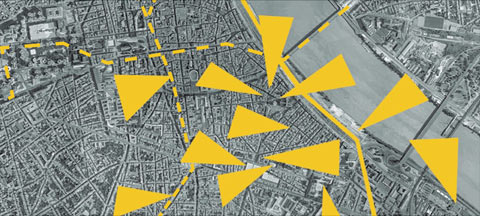
In the spring of 2011, Cittadellarte invited local and international artists to work in the Bordeaux area, to create “urban transformation sites”: open and participated creative workshops to host events and installations.
Among the various practises cohabiting within the Urban Art Biennial, the Artecittà exhibition present the urban research by Cohabitation Strategies (Lucia Babina, Emiliano Gandolfi, Thomas Purcell, Gabriela Rendón, Miguel Robles-Durán), a cooperative that focuses on conditions of socio-spatial exclusion within the contemporary city and that attempts to overcome the traditional bifurcation of planning and development by bringing together architecture and radical urban design with experts from professional, academic, and artistic worlds that engage in the city.
Nodos de desarrollo cultural
Cultural development node no. 1 “El Morro”
curated by El puente_lab (Juan Esteban Sandoval, Alejandro Vasquez Salinas, Daniel Urrea Peña)

The project was developed through the formation of an international and interdisciplinary team that included STEALTH.unlimited (The Netherlands/ Serbia) and a group of architects, artists and architecture students from the city of Medellín. During a three weeks workshop, parameters for the search of materials were set and some initial design options for the spaces were identified, considering the needs of use the CDCM (Centro de Desarrollo Cultural de Moravia) has requested. During the first months of 2011 three spaces were realized, mainly using recycled materials, and employing artisans from the neighbourhood. The extension of the CDCM gives a possibility of decentralising the activities of the centre, strengthening its presence in the territory and its role as aggregation space for the neighbourhood. The main objective of this process, that expands the range of existing cultural institution by multiplying its space with temporary cheap structures, is to increase access to cultural activities for community and create a network of sites to strengthen community development processes.
Juan E. Sandoval, El puente_lab
www.elpuentelab.org
Identità al centro
curated by artway of thinking with Love Difference and snark - space making
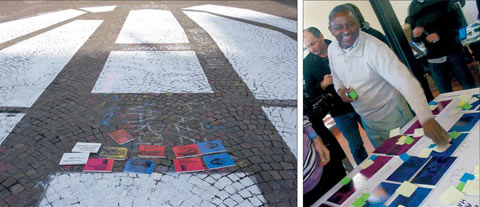
text from the final report of “Identità al Centro”
SANREMO
Casinò
curated by 5 STONES collective (Anna Moreno, Jobelle Tayawa, Kosta Tonev)
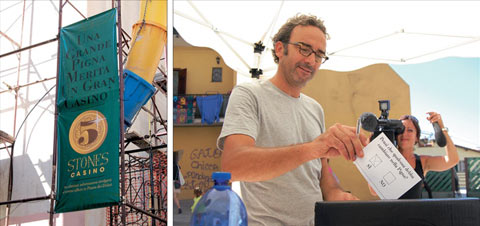
With the creation of a fake announcement spread around the city through hanging posters and banners with slogans and logos, a phantom multinational company called “5 Stones Casino” informed the population about the possible acquisition of a historical building in La Pigna: the church of Santa Brigida, which has been under restoration for over 15 years. The company is planning to transform it into a Casino.
The population was informed that a public referendum would be held in the square of Santa Brigida, in which they would we able to vote whether they agree with this change or not. The day of the referendum, a debate table was arranged in Piazza Santa Brigida. When the inhabitants approached it, they were informed about the fake and invited to join a wider debate on the concept and the need of change in their neighbourhood.
In a context like La Pigna, the question of conservation and the idea of progress acquire a particular significance, especially when related to Sanremo and the kind of amusement and leisure facilities the city offers.
5 Stones is a collective founded in 2010 by the artists Anna Moreno (1984), Jobelle Tayawa (1986) and Kosta Tonev (1980). The collective is named after the Palestinian game, 5 Stones.
5 Stones
It Runs in the Neighborhood
Jeanne van Heeswijk
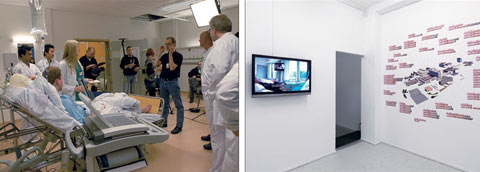
curated by Jeanne van Heeswijk and staff members of Stavanger University Hospital
contribution: Stavanger European Capital of Culture 2008
Duration: 01.05.2008 – 17.10.2008
Location: Stavanger University Hospital, Stavanger
Participants: employees of the hospital
Number of episodes: 6 episodes
Exhibitions: Stavanger Capital of Culture (2008), RAM gallery Rotterdam (2010), International Film Festival Rotterdam (2010)
Neighbourhood Secrets was an international art project in a public space as part of Stavanger 2008 Capital of Culture. Eight strong international artists from the four corners of the world have been in close contact with eight places in Stavanger and Sandnes over a period of one and a half year.
Jeanne van Heeswijk was one of the artists who took part in the project. In cooperation with the Stavanger University Hospital (SUS) she developed the first hospital TV-soap in Norway. With over 5.500 employees and almost 50.000 patients a year, the hospital can be seen as a community on it self. A community with its own communication structure and media. It runs in the Neighbourhood is a six-episode hospital soap based on real life situations. The purpose was to give the public an insight in the life inside the hospital and the medical and ethic dilemmas that the hospital employees encounter.
The six episodes where shown on the internet, on public screens and on television. At the same time, the Stavanger University Hospital (SUS) communicated directly with the public via a new interactive website on the issues raised by the series.
Jeanne van Heeswijk
situa.to: il primo luogo dove sono possibile
curated by a.titolo (Giorgina Bertolino, Francesca Comisso, Nicoletta Leonardi, Lisa Parola, Luisa Perlo) and Maurizio Cilli
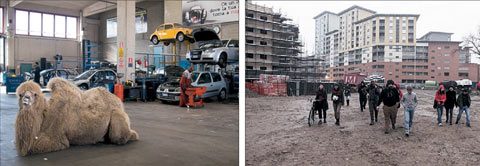
On the occasion of Your Time / TORINO 2010 YOUTH CAPITAL, the project Situa.to, supported by Regione Piemonte and Città di Torino wants to conceive new tools that read urban changes in the same way the younger generations do in order to then carry out a project involving urban art and street furniture, that are new shapes and new marks able to narrate the changes that are going on in Turin as in other contemporary cities.
Thirty girls and boys are taking part in shaping the Situa.to project through a collective and multidisciplinary experience, specialising as artists, architects, designers, video and film makers, writers, performers, graduate and undergraduate students at both humanistic and scientific university. Situa.to is a “learning by doing” project, made up of practical and theoretical meetings, workshops and lectures given by artists and architects of urban art and by experts in social sciences. This project is composed of multiple “urban views” that look at the city: neighbourhoods, boundaries, routes and their inhabitants’ stories.
a.titolo e Maurizio Cilli
Il Tappeto Volante nel quartiere di San Salvario a Torino
project by Education Department of Castello di Rivoli, curated by Anna Pironti
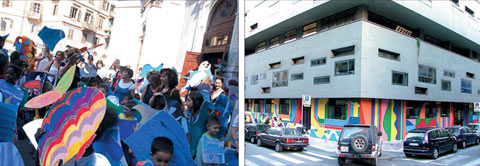
Identity and difference qualify the experience that puts the person at the centre in order to carry out a long term course of inclusion in the lively, inhomogeneous, social context.
Within the project, which sees the participation of the whole community, countless activities are planned, for example wall drawing in order to requalify the gaps in daily life and events open to all which act as significant moments of a project that became a symbol of the area’s rebirth.
Anna Pironti
Open futures
curated by STEALTH.unlimited (Ana Dzokic and Marc Neelen)
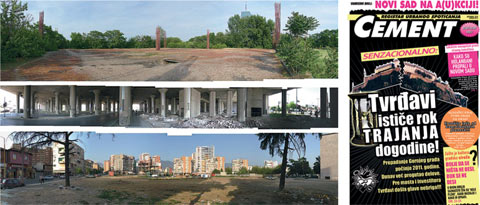
Open Futures, still here to be claimed consists of photographic recordings of large and strategically important vacant urban areas in nine emerging capitals of the Western Balkans (Ljubljana, Zagreb, Novi Sad, Belgrade, Pristina, Skopje, Tirana, Podgorica, Sarajevo). The project has important fictional dimensions: the sites are architecturally empty, however, they are full of stories. STEALTH.unlimited constructed an imaginary map out of real places – an ultimate fiction that combines all vacant spaces into “strategic emptiness” – a potentiality yet to be constructed. (By 2011 about half of the recorded sites have been modified or built).
A(u)ction – Novi Sad’s log of spaces between personal interests and public needs resulted in a tabloid format newspaper called Cement (12.000 copies) which uses the visual and journalistic language of popular Serbian media. On 24 pages, Cement investigates the field of play that defines some of the most remarkable dynamic, non-regulated and disturbing changes of the city and how they reflect to the public interest.
STEALTH.unlimited
If the city is the brain of the civitas that originates it, the contrary is also true: the civitas is the expression of the city, that is to say, the result of the connections that form it.
This is the scenario for the works and research of Cittadellarte, as its very name has announced since its inception. It investigates and undertakes concrete works (as imposed by the nature on which Cittadellarte is founded) on the experiences that can be observed today, in progress at every latitude, of this relationship between culture and city. Cittadellarte has always dedicated particular attention to the experiences of artists and collectives involved in the transformation of the city. Turning the name “Cittadellarte” (City of art – tn) with the term “artecittà” (artcity) we almost manage to touch on this concept that attempts to grasp the paradox of the organic relationship between the city and art: at the same time considering the plastic capacities and the nature of art as being the result of the dynamics and connections emerging between the vital elements that cohabit in the space and within the diffused networks.
The 14th edition of “Art at the Centre of a Responsible Transformation of Society” therefore writes the first page of draft of a sort of atlas of the artcity, the relationship between artistic practises and urban contexts.
The exhibition “Artecittà, art and urban transformation” presents a range of practical experimentations, some of which comprising the work of Cittadellarte itself and its desire to deploy itself in real dimensions by working within very different urban contexts: from the megalopolis of Medellin in Colombia to the historic centre of the city of Sanremo, from the European city of Bordeaux to the medieval city of Montevarchi in Tuscany.
The Art at the Centre review 2011 will then be presenting a selection of works from FRAC Piedmont, the first Regional Fund for Contemporary Art in Italy, started by Piedmont Region and Artissima, managed this year by Cittadellarte. The exhibition, entitled “Dialogues on architecture”, is curated by Francesco Manacorda, director of Artissima, and proposes dialogue both with the theme of Artecittà and with the workshop of UNIDEE (the international residence programme for artists, as previously mentioned, held at Cittadellarte between the 15th of June and the 15th of October): the UNIDEE residents will be invited to offer their responses to the suggestions of the exhibition during the residency period, which will then be incorporated in a further exhibition to be held in October.
In 2011 Cittadellarte was appointed by the Cultural Direction as the FRAC permanent seat with the primary aim of highlighting not only the purposes of the collection in terms of exhibition, but also and above all the educational and didactic importance of this collection. With the theme of Artecittà, “Art at the Centre 2011” articulates a reflection on the basic vision identified by the concept of the Third Paradise, through which Pistoletto outlines a new perspective centred on the balance between the natural and the artificial paradigms, a third pathway in which human intelligence cooperates with nature in the realisation of a Utopia, a paradise of human dimensions.
With this vision Cittadellarte has invited a truly polyhedral artist, Alessandro Bergonzoni, with an exhibition entitled “GREMBI: soglie dell'inconcepibile” (“WOMBS: thresholds of the inconceivable”).
Paolo Naldini
Director Cittadellarte-Fondazione Pistoletto

in the within of "Festival Architettura in Città",
promoted by Ordine and Fondazione dell'Ordine degli Architetti di Torino
www.architetturaincitta.it
Michelangelo Pistoletto
Director:
Paolo Naldini
Project research and exhibition concept curated by:
Juan Esteban Sandoval and Sara Conforti
Project manager:
Alessandro Lacirasella
José Roberto Farneda, Fabrizio Lanza, Loris Bellan, Dario Zordan, Andrea Oitana, Daniele Garella
Graphic Design:
Liudmila Ogryzko
Press Office:
Margherita Cugini, Luca Furlan
In partnership with:
Regione Piemonte, Compagnia di San Paolo, Fondazione CRT
Aknowledgments:
Reale Mutua Assicurazioni, Ideazione srl, Lauretana spa

